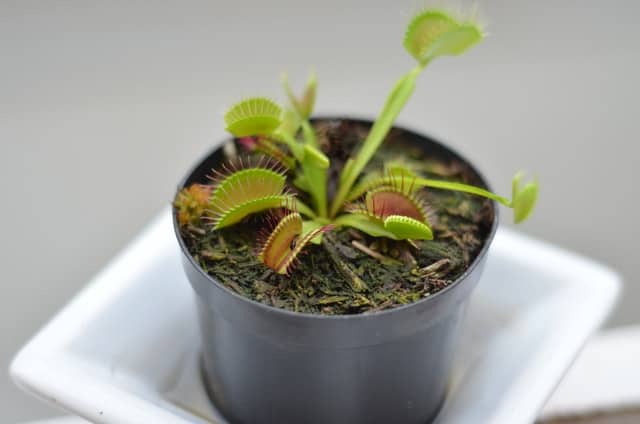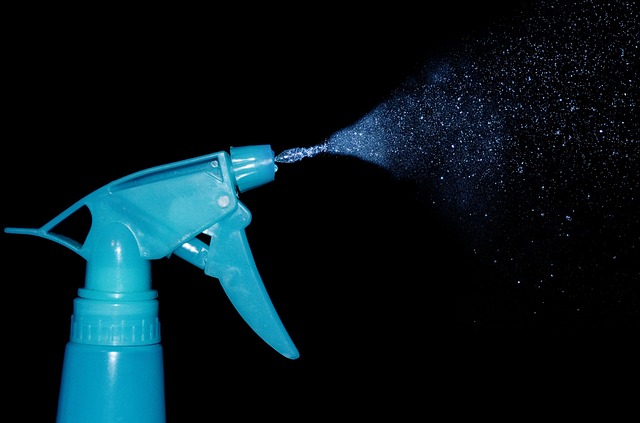When you own a Venus flytrap, you must water your plant properly to keep reasonable humidity levels. Since I live in a very dry place, I was curious about the benefits of misting. Should you mist your Venus flytrap? Here is an explanation.
The Venus flytrap does not usually require misting. A light mist is appropriate when Venus flytraps live in an arid environment. Also, you might consider misting your Venus flytrap with foliar fertilizer during the growing season to strengthen the plant.
In the wild, Venus flytraps grow in humid environments. You can mist your plant to up the humidity index; however, you must be careful with the amount of water in the soil. Keep on reading; this article will help you achieve the balance between misting and watering your plant!
Misting Venus Flytraps
In the wild, Venus flytraps live in humid environments. They grow in South Carolina and North Carolina in the United States. There they encounter humidity levels of over 50% regularly.
Even though Venus flytraps are used to humid environments, they do not require swamp-like conditions. They are not aquatic plants or used to boggy environments.
Misting your plant is an easy solution to up the humidity level surrounding its environment. It is only a good idea when living in very dry climates. For example, I live in Phoenix, Arizona, and the weather is dry year-round. I sometimes struggle to keep the environment for my Venus flytraps adequately moist. I have sprayed my plants, but I prefer to use alternative solutions to keep humidity levels high. Here are the two reasons why I prefer alternate solutions rather than misting:
- It is challenging to be consistent: Where I live, the weather is dry all the time. It is hard for me to mist my plant manually on an ongoing basis.
- Humidifiers keep the exposed soil moist: I considered using a humidifier in the past, but I got discouraged after some research. Humidifiers help you level the humidity in the environment. Yet, with plants, they can sometimes moisten the exposed layer of the soil. The problem with that is that you won’t be able to identify when do you need to water your plant. The ground might be dry throughout, but moist on the very top.
It is not harmful to mist your plant, but if your main goal is controlling the humidity level surrounding your plant, there are other options. First, you must focus on watering your plant correctly. Then, you should explore how to increase the humidity index with some of the methods below.
Humidity Requirements for Venus Flytraps
One of the primary considerations when caring for a Venus flytrap is watering.
Venus flytraps grow naturally in humid environments. Watering Venus flytraps at appropriate levels is the most crucial factor in regards to soil and environmental humidity. You will have to water your plant often to keep the soil moist.
There is no watering frequency rule that I could share with you because each location is different. For example, growing Venus flytraps in hot temperatures will require a lot more water than in cold places.
The best rule of thumb for watering your Venus flytrap is to water all around the pot until the soil is moist. You should be able to press your finger in the ground and feel the wet, yet not damped soil. Then, you should let the soil almost dry-out before you water again.
Venus flytraps require special water. You can’t water your plant with tap water or even standard bottled water. You must always use nutrient-free mineral-free water, such as:
- Rainwater
- Distilled water
- Reverse osmosis water
Just by following this watering advice, your plant will have all the water and humidity it needs. Still, you can help your plant adapt better to the climate by introducing more humidity by using a water container.
The Water Tray Strategy
Find a large plate or container that can fit your Venus flytrap pot inside of it. Make sure the container is not very shallow. It should be similar to the one shown in the picture below.

Now, you can add some water to the container. Remember! It should always be mineral-free water. Only add a thin later of water (1-2 centimeters). The water in the recipient will help moisten the environment and will act as a water reserve.
I personally use this strategy, and it works very well. I employ it half of the year, during early summer, summer, and early fall as temperatures are very high where I live. During winter or late fall, there is no need to add extra water, especially during dormancy.
Terrariums and Humidity
Terrariums are trendy nowadays, as plant lovers start to experiment with this close environment concept. Venus flytraps can live in a terrarium, but it is not optimal.
Venus flytraps appreciate the humidity inside a terrarium, which resembles their natural environment. Yet, moisture and water are not the only factors.
Venus flytrap should go through a dormancy period in the winter. Inside a terrarium, it is challenging to achieve dormancy. Also, Venus flytraps need to consume bugs to thrive. Close terrariums do not offer the possibility of feeding.
Fertilizer Mist for Venus Flytraps
The general advice towards fertilizers and Venus flytraps is to abstain from fertilizing your plant. The only reason why this advice is so strict is because it is targeted towards novice growers.
It is possible to lightly mist your plant with fertilizer to strengthen its growth. Yet, new Venus fly trap growers tend to get overly excited with fertilizer (as they should be with most plants) and they forget Venus flytraps have a low tolerance towards nutrients and minerals.
You can mist your plant with fertilizer as long as you follow these considerations:
- Only fertilize your plant during the growing season
- Only fertilize indoor plants or plants that do not have access to feed
- Do not saturate the soil with fertilizers
- Employ weak foliar sprays as fertilizers
Now, lets go over more detail in those items:
Main Considerations
Only fertilize your plant during the growing season
There is no need to fertilize your plants during dormancy. During such a period, your plant is hibernating and should be left alone for a few months. Your Venus flytrap won’t grow during this period; it will shrink instead.
Only fertilize indoor plants or plants that do not have access to feed
When Venus flytraps grow outdoors, they do not require an additional boost to develop as they can cratch insects. Venus flytraps consume bugs to boost their diet and thrive.
Indoor Venus flytraps need the extra boost with fertilizers due to the lack of access to prey, but outdoor Venus flytraps are better off without it.
Do not saturate the soil with fertilizers
A good rule of thumb is to fertilize your plant once every 2 to 3 months during the growing season. Always do it lighting, never saturate the soil.
In their natural habitat, the Venus flytrap grows in impoverished soil. They are not used to handling minerals or other nutrients. Over-fertilizing can kill your plant, so do it carefully.
Employ foliar sprays as fertilizers
Mist your plant with foliar fertilizer to provide the extra boost. Foliar fertilizers are meant to be sprayed on the leaves of the plant. Maxsea is a gentle foliar fertilizer suitable for Venus flytraps and other carnivorous plants.
Alternatives to Fertilizers
It is not necessary to fertilize your Venus flytrap if you follow these care considerations:
- Focus on proper feeding: Venus flytrap gets essential nutrients from prey thy capture. Outdoors, Venus flytraps can capture their feed, but indoors they tend to struggle. Feed yous Venus flytrap when they are placed indoors. Feeding your plant can be a lot more effective than fertilizing your plant as it is a natural process. Check this guide on Feeding a Venus flytrap if you are not familiar with the process. it is not too hards, but it should be done correctly.
- Do not let your plant flower: During spring, Venus flytraps produce flowers for reproductions. Your plant will spend substantial amounts of energy producing those flowers. If you want to accelerate your plant’s growth, then you should cut off the flower stalks as soon as you spot them. Your plant will save energy and focus on growing and developing. More information about the subject here:
Sources
- https://www.fws.gov/southeast/pdf/fact-sheet/venus-flytrap.pdf
- D’Amato, P. (2013). The Savage Garden. Berkeley, Unites States: Ten Speed Press


